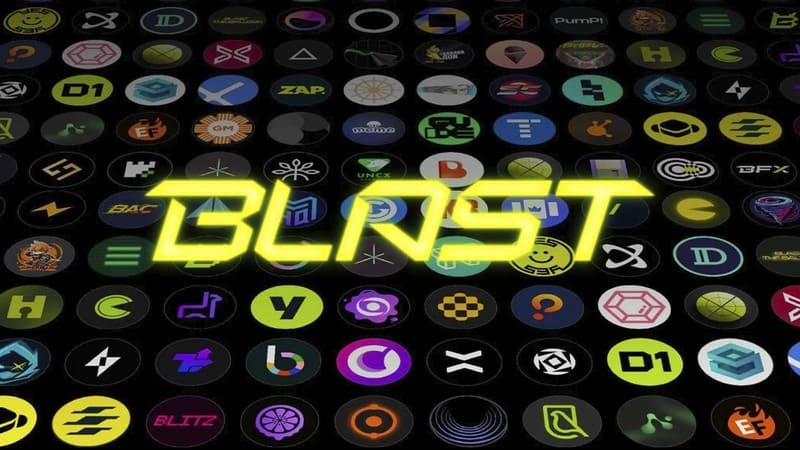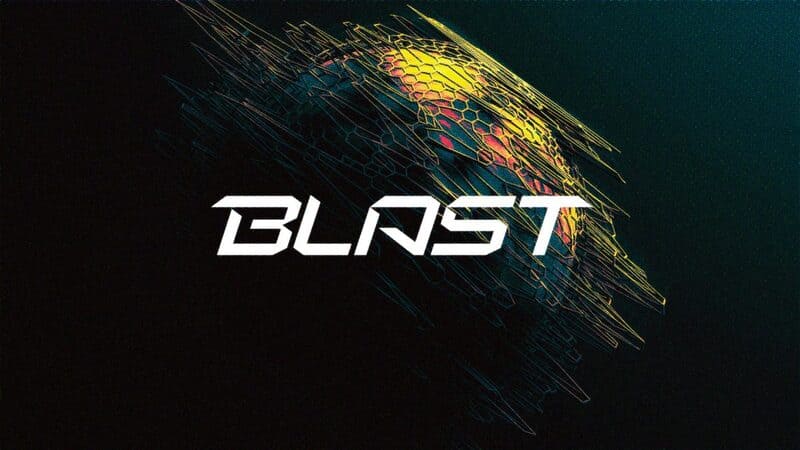Curious about what is Blast crypto and why it’s gaining so much attention? This article dives deep into the key features, rewards, and opportunities that Blast offers to crypto enthusiasts. From understanding its native yield to uncovering airdrop rewards, keep reading to explore everything you need to know about this emerging Layer-2 solution on Ethereum.
What is Blast Crypto?
Blast is a Layer-2 solution built on Ethereum, aiming to bring native yield to ETH and stablecoins. Unlike other Layer-2 networks, where default interest rates are usually 0%, Blast offers 3.4% yield on ETH and 8% on stablecoins like USDT, USDC, and DAI. This yield is sourced from ETH staking and Real-World Asset (RWA) protocols. The main idea behind Blast is simple: instead of holding your ETH or stablecoins passively, you can earn a steady yield just by transferring them to the Blast Layer-2 network.
How does Blast work?
Blast works by utilizing Ethereum’s Layer-2 technology. Layer-2 protocols like Blast help Ethereum scale by offloading transactions from the main blockchain (Layer-1) while still maintaining the security of the Ethereum network. The process of staking ETH on Layer-2 through protocols like Lido allows users to earn rewards based on the amount of ETH they hold. For example, Blast automatically stakes the ETH you bridge into its network, offering you a yield of 3.4%. This yield compounds directly in your wallet, meaning that you don’t have to do anything after moving your assets.
When it comes to stablecoins, the process is slightly different. Stablecoins like USDT, USDC, and DAI are tokenized into treasury-bill products that yield 5%. This yield is higher than what you would get from holding these assets on the Ethereum Layer-1 chain. Plus, these yields are passed directly to your wallet, eliminating the need for any extra steps.
Real-world assets (RWAs) in Blast
RWAs play a crucial role in Blast’s ability to offer higher yields. Real-World Assets are essentially tangible assets like real estate or commodities tokenized and used within decentralized finance (DeFi) protocols. In Blast’s case, RWAs are integrated to generate yield, adding another layer of profitability beyond just ETH staking. This gives Blast an advantage over other Layer-2 protocols that don’t tap into the world of real assets. For instance, while other L2 solutions focus purely on transaction scalability and reducing fees, Blast ensures that every bridged asset continues to work for you by yielding real returns.
Key features of Blast
- ETH staking with a 3.4% yield: The main attraction for users is the automatic staking of ETH, allowing them to earn without needing to interact directly with staking platforms.
- Stablecoin yield of 8%: Stablecoin holders on Blast benefit from a much higher yield than they would on the Ethereum Layer-1 network, thanks to its integration with tokenized treasury-bill products.
- Gas revenue sharing: Another feature that sets Blast apart is its revenue-sharing model. Developers who build Dapps (Decentralized Applications) on Blast can share in the network’s gas fees, making it more attractive to build applications on this Layer-2 network.
- No lockup period: Unlike some other yield-generating platforms, Blast doesn’t lock up your assets, which means you can access your funds whenever you want.
Yield Source and Sustainability
The sustainability of Blast’s yield comes from two major sources. First, ETH staked in Blast is staked through Lido Finance, a leading Ethereum staking platform. Lido allows users to stake their ETH while still maintaining liquidity, meaning that users can earn staking rewards without locking up their ETH for long periods.
The second source of Blast’s yield comes from Real-World Asset (RWA) protocols like MakerDAO. By tokenizing treasury bills and other real-world assets, Blast is able to offer a 5% yield on stablecoins, which is much higher than traditional banking systems. These stablecoins are kept liquid, meaning they can be withdrawn or traded at any time, making Blast a sustainable platform for yield generation.
How to claim Blast airdrops and rewards
Blast Phase 1 airdrop claim:
- Visit the airdrop page: Start by visiting Blast’s official airdrop claim page to begin the process.
- Sign in to claim your airdrop: Click “Sign in to claim your airdrop” and connect your wallet to the platform.
- Watch the Blast video: After connecting your wallet, you’ll be prompted to watch an informational video about Blast.
- Check your eligible tokens: Once the video finishes, you’ll see the number of tokens you’re eligible to claim.
- Tweet and install the app: Follow the instructions to tweet a pre-written message and install the Blast app.
- Receive codewords: After installing the app, you’ll receive four codewords.
- Submit the codewords: Go back to the airdrop claim page and submit the codewords you received from the app.
- Claim your tokens: After submitting the codewords, your tokens will automatically be sent to your wallet.
- 30-day claim period: Eligible users have 30 days to claim their tokens.
Who is eligible for the airdrop?
- Users who bridged ETH or USDB to Blast during Phase 1 and helped bootstrap the initial liquidity will receive 7% of the total BLAST supply.
- Contributors to the success of Dapps on Blast will receive Blast Gold and also be rewarded with 7% of the total BLAST supply.
- The Blur Foundation will receive 3% of the total BLAST supply to distribute within the Blur community via both retroactive and future airdrops.
Vested Token Conditions:
- The top 1,000 wallets will receive their tokens on a 6-month vesting schedule. You will need to reach specific point milestones to unlock the vested tokens.
Blast Phase 2 airdrop claim:
- Visit the Blast website: To join Phase 2, head to the official Blast site and use the invite code WS7XR to sign up.
- Connect your wallet and follow on social media: After signing up, connect your wallet and follow Blast on Twitter and Discord.
- Bridge ETH or other tokens: To be eligible for the airdrop, transfer ETH or other supported tokens from Ethereum to Blast L2.
- Earn points and interest: Once you’ve completed the bridge, you’ll start earning Blast points based on the amount you transferred. You will also earn 4% interest on ETH and 5% on stablecoins.
- Phase 2 token allocation: 10 billion BLAST tokens have been allocated for Phase 2, with 50% reserved for Blast points and the remaining 50% for users earning Blast Gold through Dapp interactions.
- Referral program: Earn additional points and Blast Gold by inviting others to join using your referral link.
- Multiplier Campaign: You can increase your points through the Multiplier Campaign, which rewards users for interacting with certain featured Dapps.
Make sure to participate in Phase 2 to continue accumulating points and qualify for future airdrops.
Potential risks and criticisms
As with any new platform, there are some risks to consider. One of the main criticisms of Blast is its reliance on Lido Finance for ETH staking. Lido currently controls a large percentage of the Ethereum staking market, which raises concerns about centralization. If Lido were to experience issues or attacks, it could have a significant impact on the entire Ethereum network, including platforms like Blast that rely on it.
Another concern is the multisig contract used to manage user deposits. Since the Blast mainnet is not yet live, all deposits are currently held in a multisig wallet, meaning that three of five signers must approve any transaction. If these signers were compromised, it could put user funds at risk.
Finally, some users have likened Blast’s referral system to a pyramid scheme. While this comparison may be harsh, it’s important to understand that early adopters who refer others will indeed benefit more than users who join later. However, unlike traditional pyramid schemes, Blast’s system offers actual yields based on ETH and stablecoin staking, making it less speculative.
Blast vs. Other Layer-2 Solutions
When comparing Blast to other Layer-2 solutions like Arbitrum or Optimism, the main difference lies in the native yield offered by Blast. While Arbitrum and Optimism focus on scalability and reducing transaction costs, Blast adds an extra layer of value by offering yield on assets held within the network. This makes Blast a more attractive option for users looking to both save on gas fees and earn passive income.
Additionally, Blast’s gas revenue sharing model sets it apart from other Layer-2 solutions. Developers who build Dapps on the network can share in the gas fees, making it a more appealing platform for those looking to create and monetize decentralized applications.
Controversies and Future Outlook
Blast has not been without its controversies. The most significant issue is the fact that the mainnet has not yet launched, meaning that all assets are currently locked in a multisig contract. This has raised concerns within the community, as some users are uncomfortable with the idea of their funds being controlled by a small group of signers.
Additionally, the heavy reliance on Lido Finance for ETH staking has raised questions about centralization. While Lido is a reputable platform, its dominance in the staking market could pose a risk to Ethereum’s overall decentralization efforts.
Despite these concerns, the future of Blast looks promising. With the mainnet launch scheduled for early 2024 and an extensive rewards program in place, Blast is well-positioned to become a major player in the Layer-2 space. Whether you’re a developer looking to build on a scalable network or an investor seeking yield on your assets, Blast offers a unique opportunity to participate in the next generation of Ethereum scaling solutions.


